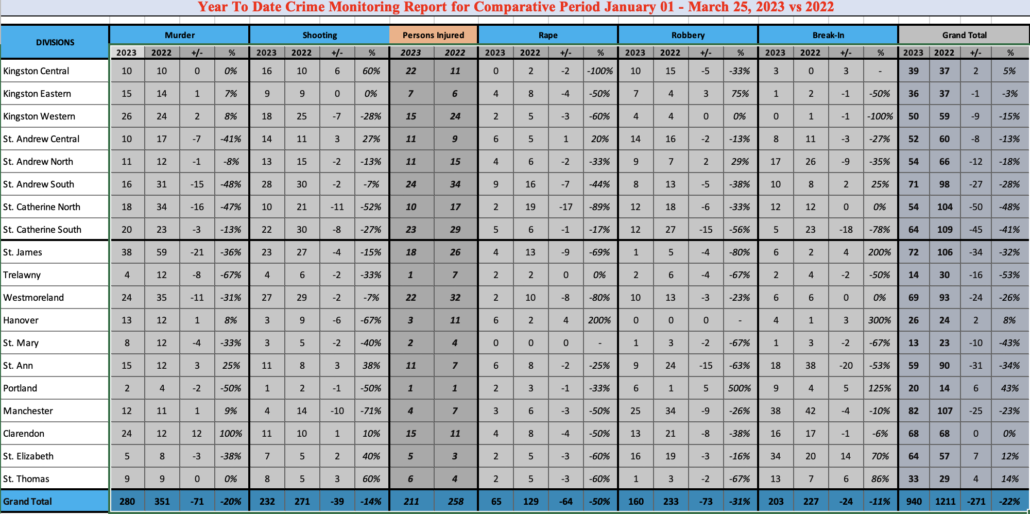By Dennis Brooks
A recent study by Paul Bourne, Dennis Brooks and Vivienne Quarrie, which was published in the International Journal of Insights & Transformations in Law, Crime & Justice provides a comprehensive look at the patterns of three select violent crimes – murders, robberies, and shootings.
One of the most alarming findings from the analysis of selected violent crimes in Jamaica between 2010 and 2022 is the rate at which murders have been occurring. In 2017, the murder rate reached its peak, with 60.37 per 100,000 population. Since 2018, four murders have been committed daily in Jamaica, which translates to one murder every six hours. This rate is concerning and points to the need for urgent action to address this grave public safety issue.
Another significant finding is that the majority of violent crimes committed in Jamaica involved the use of guns (81.1%, n=44,971; Table 3). Guns were the weapon of choice in 79.1% (n=13,341) of murders, 68.7% (n=16,310) of robberies, and 100.0% (n=16,310) of shootings. This highlights the critical need for stronger gun control measures and targeted efforts to curb illegal firearms trafficking in the country.
In terms of geographical distribution, the majority of the selected violent crimes occurred in St. Andrew (23.3%, n=13,169), St. Catherine (18.8%, n=10,615), Kingston (12.2%, n=6,901), and St. James (10.8%, n=6,102). Moreover, three in every ten selected violent crimes were committed in Area 4 policing divisions. These findings suggest that law enforcement and policymakers should focus their attention on these areas when developing crime prevention and intervention strategies.
The temporal patterns of selected violent crimes show that most of these crimes tend to occur on Fridays (9.1%, n=9,102) and Saturdays (16.1%, n=9,100), particularly in October (8.9%, n=5,011) and January (8.8%, n=4,973). Law enforcement agencies can utilize this information to optimize the deployment of resources and personnel during these peak periods to enhance public safety and deter criminal activities.
In examining the types of selected violent crimes, the analysis found that robberies constituted the largest share (41.1%, n=23,218), followed by murders (29.9%, n=16,906) and shootings (28.9%, n=16,332) (Figure 1). The fact that most of these crimes were committed by individuals on foot (82.6%, n=54,639; Table 3) may indicate the need for better community policing strategies, neighbourhood watch programs, and increased public awareness campaigns to identify and report suspicious activities.
The analysis also revealed a significant decline in the number of daily murders, robberies, and shootings since 2010, with a 43.7% reduction in these crimes between 2010 and 2022. This indicates that ongoing efforts to combat crime in Jamaica may be producing positive results. However, the persistent occurrence of these crimes demonstrates that there is still much work to be done to address the root causes of crime and create safer communities across the country.
When examining the locations of these crimes, it was found that most of them occurred on roadways (49.9%), followed by dwellings (14.6%) and premises (6.4%) (Table 12). This information can guide law enforcement in developing strategies for patrolling, surveillance, and crime prevention initiatives in these high-risk areas.
The findings of this research provide valuable insights into the patterns and distribution of selected violent crimes in Jamaica from 2010 to 2022. The concerning rates of murders, particularly in 2017, highlight the need for urgent action to protect public safety. Additionally, the prevalence of guns as the weapon of choice in these crimes underscores the importance of addressing illegal firearms trafficking and implementing stronger gun control measures.
The geographical distribution of violent crimes, with a concentration in certain parishes and policing divisions, suggests that targeted crime prevention and intervention strategies should be focused on these areas. The temporal patterns of crime occurrences, particularly during specific days of the week and months, can be useful for law enforcement agencies in optimizing resource deployment and enhancing public safety.
The decline in daily occurrences of selected violent crimes between 2010 and 2022 is encouraging and indicates that ongoing efforts to combat crime in Jamaica may be yielding positive results. However, there is still much work to be done to address the root causes of crime, improve community policing strategies, and create safer communities across the country.
Understanding the locations where crimes predominantly occur can guide law enforcement in developing effective patrolling, surveillance, and crime prevention initiatives in high-risk areas. Overall, the findings of this research offer valuable data that can inform the development of evidence-based policies and strategies to reduce violent crime in Jamaica and promote public safety.








